High Penetration of Solar Photovoltaic Structure on the Grid System Disruption: An Overview of Technology Advancement
Abstract
1. Introduction
2. Solar PV System: An Overview
2.1. Steady-State Modelling
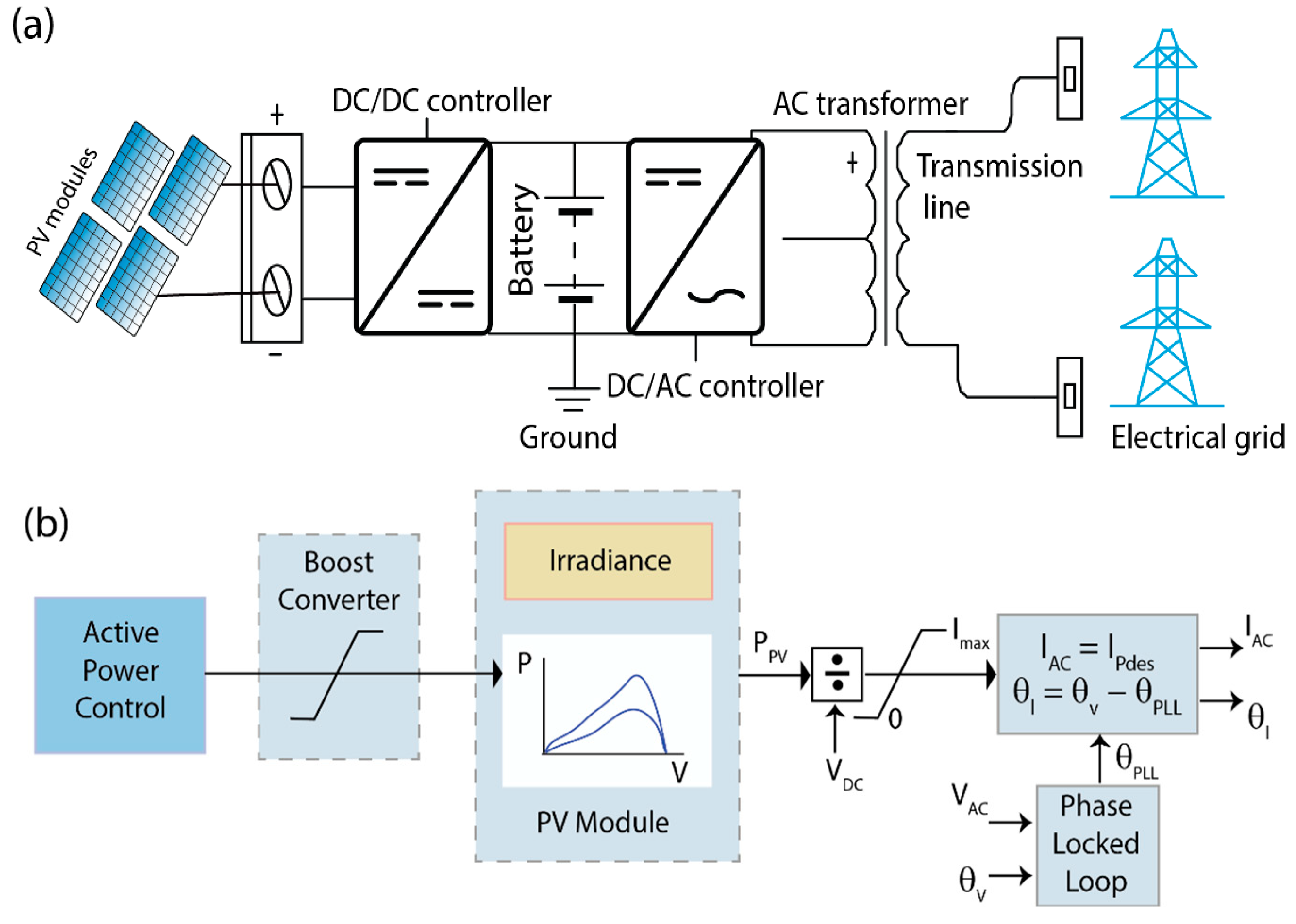
2.2. Dynamic Modelling
- (1)
- To maximize the amount of real power extracted from photovoltaic modules, MPPT (maximum power point tracking) is used [31];
- (2)
- The power level of PV modules can be verified on the DC voltage and irradiation;
- (3)
- The inverter as a function of the fixed unity power operative factor;
- (4)
- The inverter mainly represents a current source;
- (5)
- The time delay circuit is the main property of an inverter for over-and under-frequency voltage tripping;
- (6)
- The phase-locked loop (PLL) [27].
3. High Levels of PV Penetration in LV Distribution Grids
3.1. Technical Features of PV Grid-Connected Inverter
- (A)
- Main circuit structure
- (B)
- Control Strategy
3.1.1. Solar Panel Deployment for Maximum Penetration
3.1.2. Technical Framework for Photovoltaic System Interconnection
3.2. Required Control Capabilities by Photovoltaic Systems
4. High Penetration Renewable Energy
- ➢
- The Red Electrica de Espana transmission system operator’s (TSO’s) grid codes and operational procedures (POs) [64];
- ➢
- Since 2006, the Control Centre for Renewable Energy (CECRE) has been in operation. CECRE is regarded as a world-first initiative for monitoring and controlling renewable energy plants, particularly wind farms [65].
4.1. Renewable Energy Penetration in France
4.2. PV System and High Penetration
4.3. Solar PV Energy on the Grid
4.4. Development of PV Technology
5. Impact of Large-Scale Penetration
6. Comparisons Study and Importance
7. Conclusions
Future Recommendations
Author Contributions
Funding
Institutional Review Board Statement
Informed Consent Statement
Data Availability Statement
Conflicts of Interest
References
- Quan, L.; Wolfs, P. A Review of the Single Phase Photovoltaic Module Integrated Converter Topologies with Three Different DC Link Configurations. IEEE Trans. Power Electron. 2008, 23, 1320–1333. [Google Scholar] [CrossRef]
- Hubert, F.; Christoph, M. High Penetration of Photovoltaic Systems in Electricity Networks. Informacije MIDEM 2009, 39, 216–219. [Google Scholar]
- Joshua, S.H. GTM Forecasting More than 85 Gigawatts of Solar PV to Be Installed in 2017. 2017. Available online: https://cleantechnica.com/2017/04/05/gtm-forecasting-85-gw-solar-pv-installed-2017/ (accessed on 3 February 2022).
- APVI. Australian PV Institute (APVI) Solar Map Funded by the Australian Renewable Energy Agency. 2018. Available online: http://pv-map.apvi.org.au/analyses (accessed on 2 May 2018).
- Alam, M.J.E.; Muttaqi, K.M.; Sutanto, D. A comprehensive assessment tool for solar PV impacts on low voltage three phase distribution networks. In Proceedings of the 2nd International Conference on the Developments in Renewable Energy Technology (ICDRET 2012), Dhaka, Bangladesh, 5–7 January 2012; pp. 1–5. [Google Scholar]
- Walling, R.A.; Saint, R.; Dugan, R.C.; Burke, J.; Kojovic, L.A. Summary of Distributed Resources Impact on Power Delivery Systems. IEEE Trans. Power Deliv. 2008, 23, 1636–1644. [Google Scholar] [CrossRef]
- Ghiani, E.; Pilo, F. Smart inverter operation in distribution networks with high penetration of photovoltaic systems. J. Mod. Power Syst. Clean Energy 2015, 3, 504–511. [Google Scholar] [CrossRef]
- Lai, C.S.; Jia, Y.; Lai, L.L.; Xu, Z.; McCulloch, M.D.; Wong, K.P. A comprehensive review on large-scale photovoltaic system with applications of electrical energy storage. Renew. Sustain. Energy Rev. 2017, 78, 439–451. [Google Scholar] [CrossRef]
- Das, C.K.; Bass, O.; Kothapalli, G.; Mahmoud, T.S.; Habibi, D. Overview of energy storage systems in distribution networks: Placement, sizing, operation, and power quality. Renew. Sustain. Energy Rev. 2018, 91, 1205–1230. [Google Scholar] [CrossRef]
- Mendonça, H.; De Castro, R.M.; Martínez, S.; Montalbán, D. Voltage Impact of a Wave Energy Converter on an Unbalanced Distribution Grid and Corrective Actions. Sustainability 2017, 9, 1844. [Google Scholar] [CrossRef]
- Wang, H.; Wang, J.; Piao, Z.; Meng, X.; Sun, C.; Yuan, G.; Zhu, S. The Optimal Allocation and Operation of an Energy Storage System with High Penetration Grid-Connected Photovoltaic Systems. Sustainability 2020, 12, 6154. [Google Scholar] [CrossRef]
- Hashim, H.; Ho, W.S. Renewable energy policies and initiatives for a sustainable energy future in Malaysia. Renew. Sustain. Energy Rev. 2011, 15, 4780–4787. [Google Scholar] [CrossRef]
- Basri, N.A.; Ramli, A.T.; Aliyu, A.S. Malaysia energy strategy towards sustainability: A panoramic overview of the benefits and challenges. Renew. Sustain. Energy Rev. 2015, 42, 1094–1105. [Google Scholar] [CrossRef]
- Muhammed, G.; Tekbiyik-Ersoy, N. Development of Renewable Energy in China, USA, and Brazil: A Comparative Study on Renewable Energy Policies. Sustainability 2020, 12, 9136. [Google Scholar] [CrossRef]
- Husain, A.A.F.; Ahmad Phesal, M.H.; Kadir, M.Z.A.A.; Ungku Amirulddin, U.A.; Junaidi, A.H.J. A Decade of Transitioning Malaysia toward a High-Solar PV Energy Penetration Nation. Sustainability 2021, 13, 9959. [Google Scholar] [CrossRef]
- Arif, S.; Rabbi, A.E.; Ahmed, S.U.; Hossain Lipu, M.S.; Jamal, T.; Aziz, T.; Sarker, M.R.; Riaz, A.; Alharbi, T.; Hussain, M.M. Enhancement of Solar PV Hosting Capacity in a Remote Industrial Microgrid: A Methodical Techno-Economic Approach. Sustainability 2022, 14, 8921. [Google Scholar] [CrossRef]
- Hassaine, L.; Olias, E.; Quintero, J.; Salas, V. Overview of power inverter topologies and control structures for grid connected photovoltaic systems. Renew. Sustain. Energy Rev. 2014, 30, 796–807. [Google Scholar] [CrossRef]
- Zeng, Z.; Yang, H.; Zhao, R.; Cheng, C. Topologies and control strategies of multi-functional grid-connected inverters for power quality enhancement: A comprehensive review. Renew. Sustain. Energy Rev. 2013, 24, 223–270. [Google Scholar] [CrossRef]
- Kroposki, B.; Margolis, R.; Ton, D. Harnessing the sun. IEEE Power Energy Mag. 2009, 7, 22–33. [Google Scholar] [CrossRef]
- Mahapatra, S. India Achieves 20 Gigawatts Solar Capacity 4 Years Ahead of Initial Target. 2018. Available online: https://cleantechnica.com/2018/02/07/india-achieves-20-gigawatts-solar-capacity-4-years-ahead-initial-target/ (accessed on 3 February 2022).
- Business Today. India Achieves 20 GW Solar Capacity Goal Four Years Ahead of Deadline. 2018. Available online: https://www.businesstoday.in/current/economy-politics/india-achieves-20-gw-solar-capacity-goal-4-years-ahead-deadline/story/269266.html (accessed on 3 February 2022).
- Nguyen, A.; Velay, M.; Schoene, J.; Zheglov, V.; Kurtz, B.; Murray, K.; Torre, B.; Kleissl, J. High PV penetration impacts on five local distribution networks using high resolution solar resource assessment with sky imager and quasi-steady state distribution system simulations. Sol. Energy 2016, 132, 221–235. [Google Scholar] [CrossRef]
- Sepasi, S.; Reihani, E.; Howlader, A.M.; Roose, L.R.; Matsuura, M.M. Very short term load forecasting of a distribution system with high PV penetration. Renew. Energy 2017, 106, 142–148. [Google Scholar] [CrossRef]
- Gautam, D.; Vittal, V. Impact of DFIG based wind turbine generators on transient and small signal stability of power systems. In Proceedings of the 2009 IEEE Power & Energy Society General Meeting, Calgary, AB, Canada, 26–30 July 2009; pp. 1–6. [Google Scholar]
- Ullah, N.R.; Thiringer, T. Effect of operational modes of a wind farm on the transient stability of nearby generators and on power oscillations: A Nordic grid study. Wind Energy 2007, 11, 63–73. [Google Scholar] [CrossRef]
- Kundur, P.; Rogers, G.J.; Wong, D.Y.; Wang, L.; Lauby, M.G. A comprehensive computer program package for small signal stability analysis of power systems. IEEE Trans. Power Syst. 1990, 5, 1076–1083. [Google Scholar] [CrossRef]
- Achilles, S.; Schramm, S.; Bebic, J. Transmission System Performance Analysis for High Penetration PV. NRELlSR-581-42298. 2008. Available online: https://www1.eere.energy.gov/solar/pdfs/42300.pdf (accessed on 3 February 2022).
- National Grid. Winter Outlook 2014/15. 2014. Available online: http://www2.nationalgrid.com/UK/Industry-information/Future-of-Energy/FES/Winter-Outlook/ (accessed on 15 March 2022).
- Liu, Y.; Bebic, J.; Kroposki, B.; Bedout, J.d.; Ren, W. Distribution System Voltage Performance Analysis for High-Penetration PV. In Proceedings of the 2008 IEEE Energy 2030 Conference, Atlanta, GA, USA, 17–18 November 2008; pp. 1–8. [Google Scholar]
- Liu, H.; Jin, L.; Le, D.; Chowdhury, A.A. Impact of high penetration of solar photovoltaic generation on power system small signal stability. In Proceedings of the 2010 International Conference on Power System Technology, Hangzhou, China, 24–28 October 2010; pp. 1–7. [Google Scholar]
- Ahmed, N.A.; Miyatake, M. A novel maximum power point tracking for photovoltaic applications under partially shaded insolation conditions. Electr. Power Syst. Res. 2008, 78, 777–784. [Google Scholar] [CrossRef]
- Xiaohu, L.; Aichhorn, A.; Liu, L.; Li, H. Coordinated control of distributed energy storage system with tap changer transformers for voltage rise mitigation under high photovoltaic penetration. IEEE Trans. Smart Grid 2012, 3, 897–906. [Google Scholar]
- Haque, M.M.; Wolfs, P. A review of high PV penetrations in LV distribution networks: Present status, impacts and mitigation measures. Renew. Sustain. Energy Rev. 2016, 62, 1195–1208. [Google Scholar] [CrossRef]
- Schoene, J.; Zheglov, V.; Houseman, D.; Smith, J.; Ellis, A. Photovoltaics in distribution systems–integration issues and simulation challenges. In Proceedings of the IEEE on Power and Energy Society General Meeting (PES) 2013, Vancouver, BC, Canada, 21–25 July 2013; pp. 1–5. [Google Scholar]
- Katiraei, F.; Aguero, J.R. Solar PV Integration Challenges. IEEE Power Energy Mag. 2011, 9, 62–71. [Google Scholar] [CrossRef]
- Dong, M.; Luo, A. Design and Control of inverters for PV gridconnection generation system. J. Power Syst. Autom. 2006, 30, 97–102. [Google Scholar]
- Zhou, M. Report for reviewing the renewable energy and energy saving in USA. J. Renew. Energy 2007, 25, 98–101. [Google Scholar]
- Carrasco, J.M. Leopoldo Garcia Franquelo. Power-Electronic Systems for the Grid Integrationof enewable Energy Sources: A Survey. IEEE Trans. Ind. Electron. 2006, 53, 1002–1016. [Google Scholar] [CrossRef]
- Haeberlin, H. Evolution of Inverters for Grid connected PV-Systems from 1989 to 2000. In Proceedings of the 17th European Photovoltaic Solar Energy Conference, Munich, Germany, 22–26 October 2001. [Google Scholar]
- Clerk Maxwell, J. A Treatise on Electricity and Magnetism, 3rd ed.; Clarendon: Oxford, UK, 1892; Volume 2, pp. 68–73. [Google Scholar]
- IEA-PVPS. Innovative Electrical Concepts. 2001. Available online: https://www.iea-pvps.org/index.php?id=9&no_cache=1&tx_damfrontend_pi1%5BshowUid%5D=397&tx_damfrontend_pi1%5BbackPid%5D=9 (accessed on 20 March 2022).
- Feng, D. Principle and Application of Solar Energy Generation; People’s Posts and Telecommunications Press: Beijing, China, 2007; pp. 56–58. [Google Scholar]
- Denholm, P.; Margolis, R.M. Evaluating the limits of solar photovoltaics (PV) in electric power systems utilizing energy storage and other enabling technologies. Energy Policy 2007, 35, 4424–4433. [Google Scholar] [CrossRef]
- Khoie, R.; Yee, V.E. A forecast model for deep penetration of renewables in the Southwest, South Central, and Southeast regions of the United States. Clean Technol. Environ. Policy 2015, 17, 957–971. [Google Scholar] [CrossRef]
- Brinkman, G.L.; Denholm, P.; Drury, E.; Margolis, R.; Mowers, M. Toward a Solar-Powered Grid-Operational Impacts of Solar Electricity Generation. IEEE Power Energy 2011, 9, 24–32. [Google Scholar] [CrossRef]
- Shah, R.; Mithulananthan, N.; Bansal, R.C. Oscillatory stability analysis with high penetrations of large-scale photovoltaic generation. Energy Convers. Manag. 2013, 65, 420–429. [Google Scholar] [CrossRef]
- Denholm, P.; Margolis, R.M.; Milford, J.M. Quantifying Avoided Fuel Use and Emissions from Solar Photovoltaic Generation in the Western United States. Environ. Sci. Technol. 2009, 43, 226–232. [Google Scholar] [CrossRef] [PubMed]
- Perez, R.; Taylor, M.; Hoff, T.; Ross, J.P. Reaching Consensus in the Definition of Photovoltaics Capacity Credit in the USA: A Practical Application of Satellite-Derived Solar Resource Data. IEEE J. Sel. Top. Appl. Earth Obs. Remote Sens. 2008, 1, 28–33. [Google Scholar] [CrossRef]
- Denholm, P.; Mehos, M. Enabling Greater Penetration of Solar Power via the Use of CSP with Thermal Energy Storage; NREL/TP-6A20-52978; National Renewable Energy Laboratory: Golden, CO, USA, 2011. [Google Scholar]
- Denholm, P.; Margolis, R.M.; Milford, J. Production Cost Modeling for High Levels of Photovoltaics Penetration; NREL/TP-581-42305; National Renewable Energy Laboratory: Golden, CO, USA, 2008. [Google Scholar]
- Hawaii. High Penetration of Distributed Solar PV Generation. 2014. Available online: https://www.energy.gov/sites/prod/files/2014/12/f19/1-Champley-DEPresentation-Sep2014.pdf (accessed on 27 March 2022).
- Palmintier, B.; Giraldez, J.; Gruchalla, K.; Gotseff, P.; Nagarajan, A.; Harris, T.; Bugbee, B.; Baggu, M. Feeder Voltage Regulation with High-Penetration PV Using Advanced Inverters and a Distribution Management System; National Renewable Energy Laboratory: Golden, CO, USA, 2016. [Google Scholar]
- Palmintier, B.; Broderick, R.; Mather, B.; Coddington, M.; Baker, K.; Ding, F.; Reno, M.; Lave, M.; Bharatkumar, A. On the Path to SunShot: Emerging Issues and Challenges in Integrating Solar with the Distribution System; Technical Report NREL/TP-5D00-65331; National Renewable Energy Laboratory: Golden, CO, USA, 2016. Available online: http://www.nrel.gov/docs/fy16osti/65331.pdf (accessed on 27 March 2022).
- Coddington, M.; Barry, M.; Benjamin, K.; Kevin, L.; Alvin, R.; Abraham, E.; Roger, H.; Tom, K.; Kristen, N.; Jeff, S. Updating Interconnection Screens for PV System Integration; National Renewable Energy Laboratory: Golden, CO, USA, 2012. Available online: https://www.nrel.gov/docs/fy12osti/54063.pdf (accessed on 27 March 2022).
- Martin, B.; Stetz, T.; Bründlinger, R.; Mayr, C.; Ogimoto, K.; Hatta, H.; Kobayashi, H.; Ben, K.; Barry, M.; Michael, C.; et al. Is the Distribution Grid Ready to Accept Large-Scale Photovoltaic Deployment? State of the Art, Progress, and Future Prospects. Prog. Photovolt. Res. Appl. 2011, 20, 681–697. [Google Scholar]
- Seuss, J.; Reno, M.J.; Broderick, R.J.; Grijalva, S. Improving distribution network PV hosting capacity via smart inverter reactive power support. In Proceedings of the 2015 IEEE Power & Energy Society General Meeting, Denver, CO, USA, 26–30 July 2015; pp. 1–5. [Google Scholar]
- NREL. IEEE 1547 and 2030 Standards for Distributed Energy Resources Interconnection and Interoperability with the Electricity Grid; National Renewable Energy Laboratory: Golden, CO, USA, 2014. Available online: https://www.nrel.gov/docs/fy15osti/63157.pdf (accessed on 4 April 2022).
- IEA. Task 14: High Penetration of PV in Local Distribution Grids; IEA: Paris, France, 2014; Available online: https://www.researchgate.net/publication/324727329 (accessed on 4 April 2022).
- IEEE 1547-2018; IEEE Standard for Interconnection and Interoperability of Distributed Energy Resources with Associated Electric Power Systems Interfaces. IEEE: Piscataway, NJ, USA, 2018. Available online: https://standards.ieee.org/standard/1547-2018.html (accessed on 4 April 2022).
- Paz Espinosa, M. Understanding the electricity tariffdeficit and its challenges. SEFO -Span. Econ. Financ. Outlook 2013, 2, 2. [Google Scholar]
- Prol, J.L.; Steininger, K.W. Photovoltaic self-consumption regulation in Spain: Profitability analysis and alternative regulation schemes. Energy Policy 2017, 108, 742–754. [Google Scholar] [CrossRef]
- Eltawil, M.A.; Zhao, Z. Grid-connected photovoltaic power systems: Technical and potential problems—A review. Renew. Sustain. Energy Rev. 2010, 14, 112–129. [Google Scholar] [CrossRef]
- Gonzalez, A.; Keith, J. Spain’s Solar-Power Collapse Dims Subsidy Model. The Wall Street Journal. 2011. Available online: https://www.wsj.com/articles/SB125193815050081615 (accessed on 12 April 2022).
- RED. Electricity Business in Spain. 2022. Available online: https://www.ree.es/en/about-us/business-activities/electricity-business-in-Spain (accessed on 12 April 2022).
- RED. Control Centre of Renewable Energies (CECRE). 2022. Available online: https://www.ree.es/en/press-office/infographs-and-maps/control-centre-of-renewable-energies-%28cecre%29 (accessed on 12 April 2022).
- Wyns, T.; Khatchadourian, A.; Oberthür, S. EU Governance of Renewable Energy Post-2020-Risks and Options; Institute for European Studies-Vrije, Universiteit Brussel: Brussels, Belgium, 2014. [Google Scholar]
- Dalton, G.J.; Lockington, D.A.; Baldock, T.E. Feasibility analysis of renewable energy supply options for a grid-connected large hotel. Renew. Energy 2009, 34, 955–964. [Google Scholar] [CrossRef]
- ECOWAS. HOMER Software for Renewable Energy Design; Center for Renewable Energy and Energy Efficiency (ECREEE): Amherst, MA, USA, 2013. [Google Scholar]
- Kenneth, E.O.; Roland, U. Optimization of Renewable Energy Efficiency using HOMER. Int. J. Renew. Energy Res. 2014, 4, 421–427. [Google Scholar]
- Ma, W.W.; Rasul, M.G.; Liu, G.; Li, M.; Tan, X.H. Climate change impacts on techno-economic performance of roof PV solar system in Australia. Renew. Energy 2016, 88, 430–438. [Google Scholar] [CrossRef]
- AECOM. Australia’s Off-Grid Clean Energy Market Research Paper. 2014. Available online: https://arena.gov.au/assets/2014/12/ARENA_RAR-report-20141201.pdf (accessed on 12 April 2022).
- Bert, H.; Anthony, D.; Olivia, B.; Steven, R.; Lyndon, F. Identifying risks, costs, and lessons from ARENA-funded off-grid renewable energy projects in regional Australia. Prog. Photovolt. Res. Appl. 2018, 26, 642–650. [Google Scholar]
- AECOM. Australian Remote Renewables: Opportunities for Investment. 2013. Available online: https://www.assorinnovabili.it/public/sitoaper/AperNelMondo/Internazionale/Report%20Australia.PDF (accessed on 14 April 2022).
- IET. Increasing Solar Energy System & Challenges to the UK Grid. Power Academy Essay Challenge. 2016. Available online: https://conferences.theiet.org/power-academy/-documents/essay-a-akuoko.cfm (accessed on 14 April 2022).
- Hemingway, J. Estimating Generation from Feed in Tariff Installations. 2013. Available online: https://assets.publishing.service.gov.uk/government/uploads/system/uploads/attachment_data/file/266474/estimating_generation_from_fit_installations.pdf (accessed on 14 April 2022).
- Hernandez, J.; Medina, A.; Jurado, F. Impact comparison of PV system integration into rural and urban feeders. Energy Convers. Manag. 2008, 49, 1747–1765. [Google Scholar] [CrossRef]
- Rowley, P.; Leicester, P.; Palmer, D.; Westacott, P.; Candelise, C.; Betts, T.; Gottschalg, R. Multi-domain analysis of photovoltaic impacts via integrated spatial and probabilistic modelling. IET Renew. Power Gen. 2015, 9, 424–431. Available online: http://digital-library.theiet.org/content/journals/10.1049/iet-rpg.2014.0374 (accessed on 15 April 2022). [CrossRef]
- Candelise, C.; Westacott, P. Can integration of PV within UK electricity network be improved? A GIS based assessment of storage. Energy Policy 2017, 109, 694–703. [Google Scholar] [CrossRef]
- ECC. Sub-National Electricity Consumption Data. Department of Energy and Climate Change. 2018. Available online: https://www.gov.uk/government/collections/sub-nationalelectricity-consumption-data (accessed on 16 February 2018).
- Ofgem. Feed-in Tarrif Register. 2014. Available online: https://www.ofgem.gov.uk/publications-and-updat (accessed on 20 April 2022).
- DECC. Renewable Energy PlanningDatabase. Department of Energy and Climate Change. 2014. Available online: https://www.gov.uk/government/publications/renewableenergy-planning-database-monthly-extract (accessed on 20 April 2022).
- Kumar, K.A.; Selvan, M.P.; Rajapandiyan, K. Grid stability analysis for high penetration solar photovoltaics. In Proceedings of the 1st International Conference on Large-Scale Grid Integration of Renewable Energy, New Delhi, India, 6–8 September 2017; Available online: https://regridintegrationindia.org/wp-content/uploads/sites/3/2017/09/10C_4_GIZ17_098_paper_AJIT_KUMARK.pdf (accessed on 20 April 2022).
- Olowu, T.O.; Sundararajan, A.; Moghaddami, M.; Sarwat, A.I. Future Challenges and Mitigation Methods for High Photovoltaic Penetration: A Survey. Energies 2018, 11, 1782. [Google Scholar] [CrossRef]
- IEA. Solar PV. 2020. Available online: https://www.iea.org/reports/renewables-2020/solar-pv (accessed on 20 April 2022).
- IRENA. Future of Solar Photovoltaic. 2019. Available online: https://irena.org/-/media/Files/IRENA/Agency/Publication/2019/Nov/IRENA_Future_of_Solar_PV_2019.pdf (accessed on 20 April 2022).
- Sampath Kumar, D.; Gandhi, O.; Rodríguez-Gallegos, C.D.; Srinivasan, D. Review of power system impacts at high PV penetration Part II: Potential solutions and the way forward. Sol. Energy 2020, 210, 202–221. [Google Scholar] [CrossRef]
- Solomon, A.A. Large scale photovoltaics and the future energy system requirement. AIMS Energy 2019, 7, 600–618. [Google Scholar] [CrossRef]
- Wilson, G.M.; Al-Jassim, M.; Metzger, W.K.; Glunz, S.W.; Verlinden, P.; Xiong, G.; Mansfield, L.M.; Stanbery, B.J.; Zhu, K.; Yan, Y.; et al. The 2020 photovoltaic technologies roadmap. J. Phys. D Appl. Phys. 2020, 53, 493001. [Google Scholar] [CrossRef]
- Khan, M.F.H. Designing a Grid-Tied Solar PV System. 2019. Available online: https://www.researchgate.net/publication/334112610_DESIGNING_A_GRID-TIED_SOLAR_PV_SYSTEM (accessed on 20 April 2022).
- Zhang, S.; Yang, J.; Shi, Y.; Wu, X.; Ran, Y. Dynamic Energy Storage Control for Reducing Electricity Cost in Data Centers. Math. Probl. Eng. 2015, 2015, 380926. [Google Scholar] [CrossRef]
- Shadfar, H.; Ghorbani Pashakolaei, M.; Akbari Foroud, A. Solid-state transformers: An overview of the concept, topology, and its applications in the smart grid. Int. Trans. Electr. Energy Syst. 2021, 31, e12996. [Google Scholar] [CrossRef]

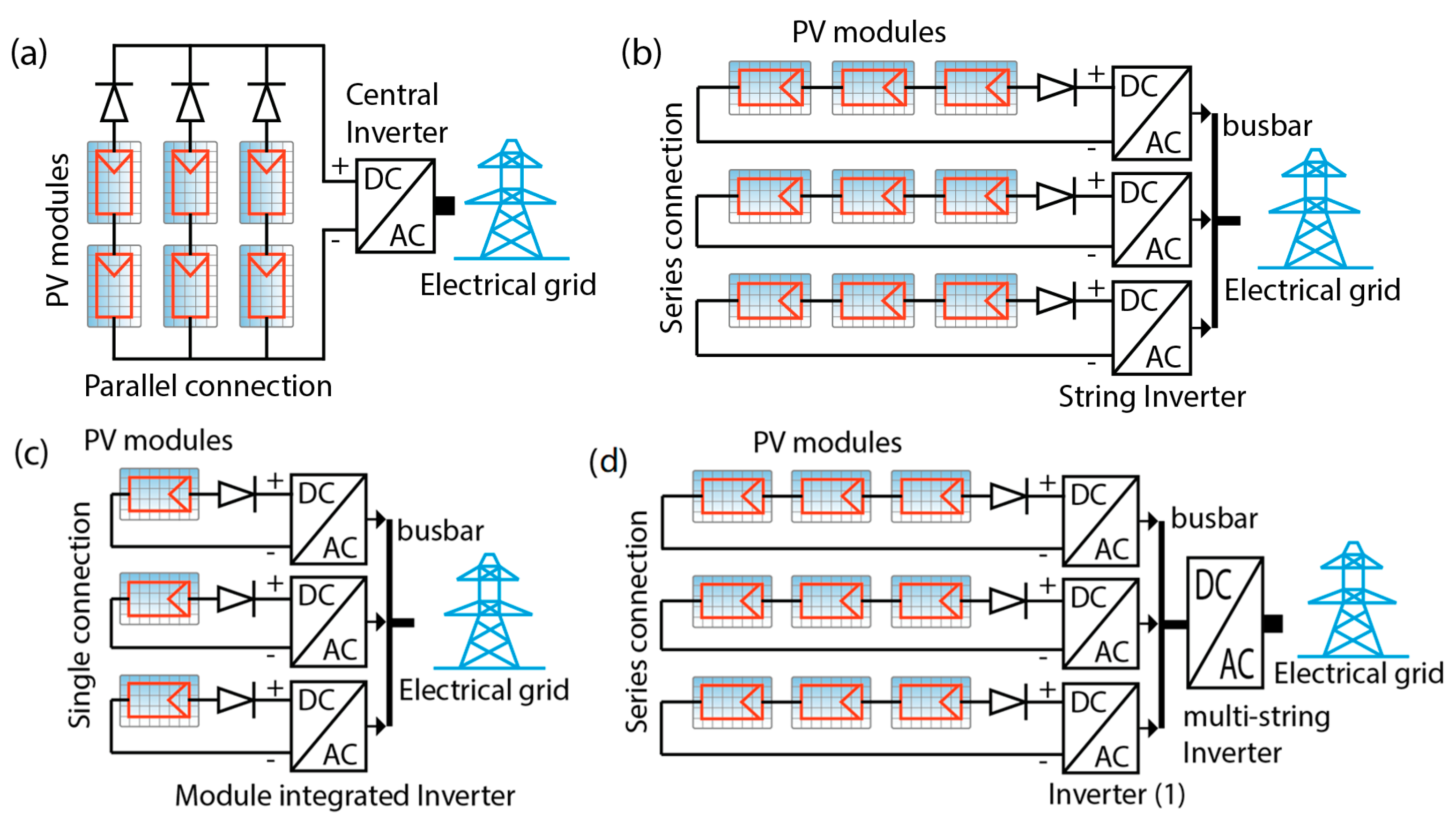
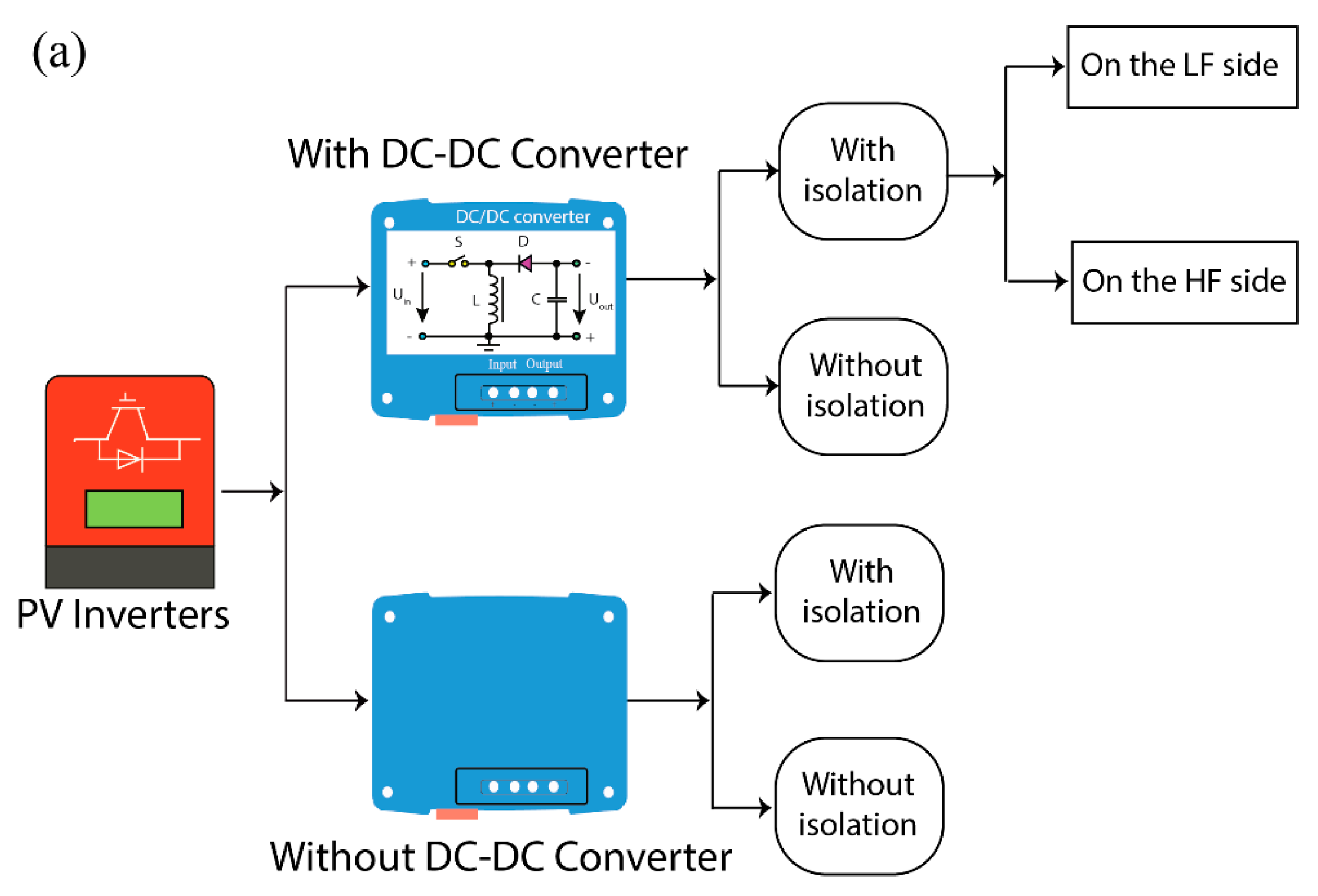
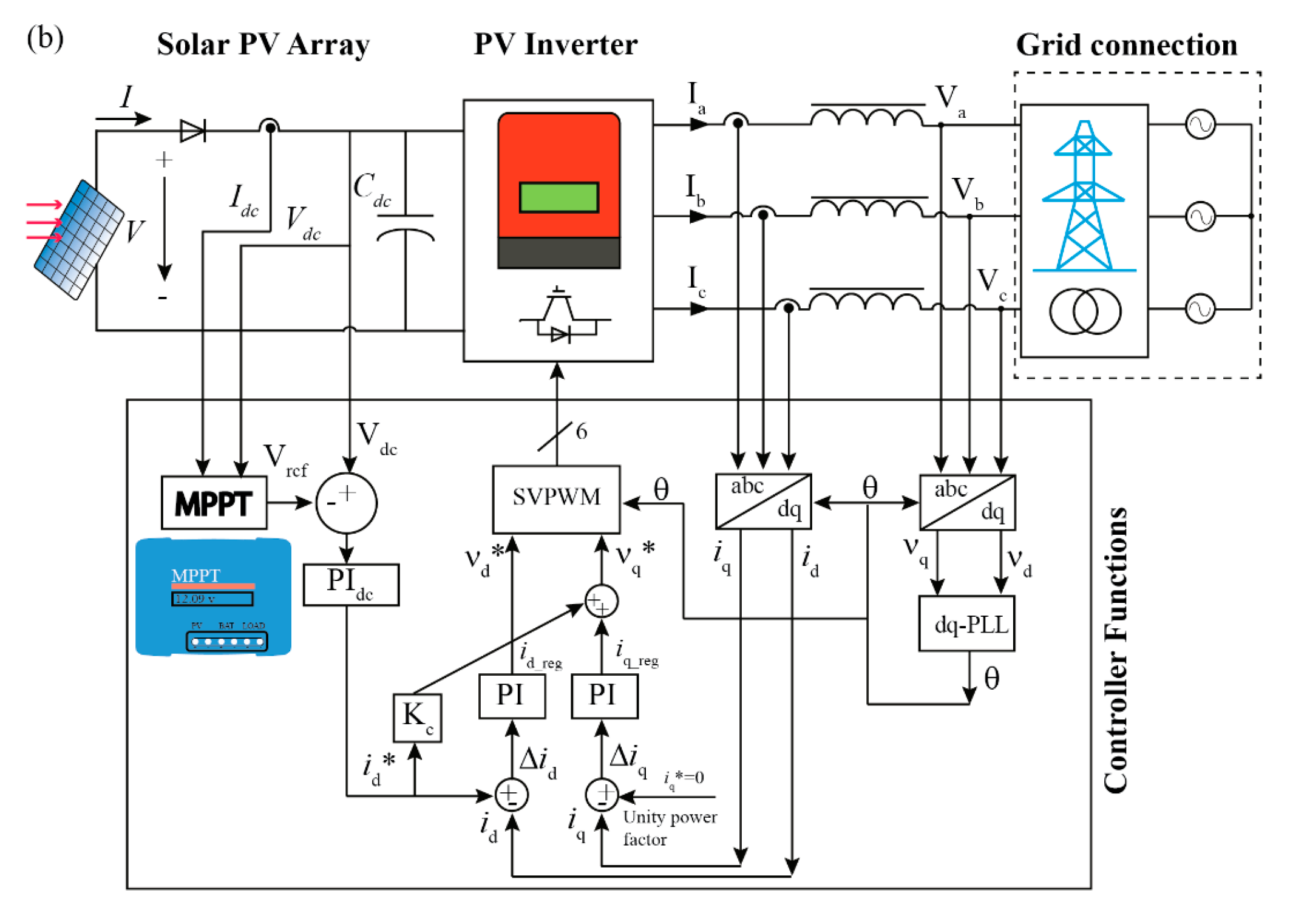
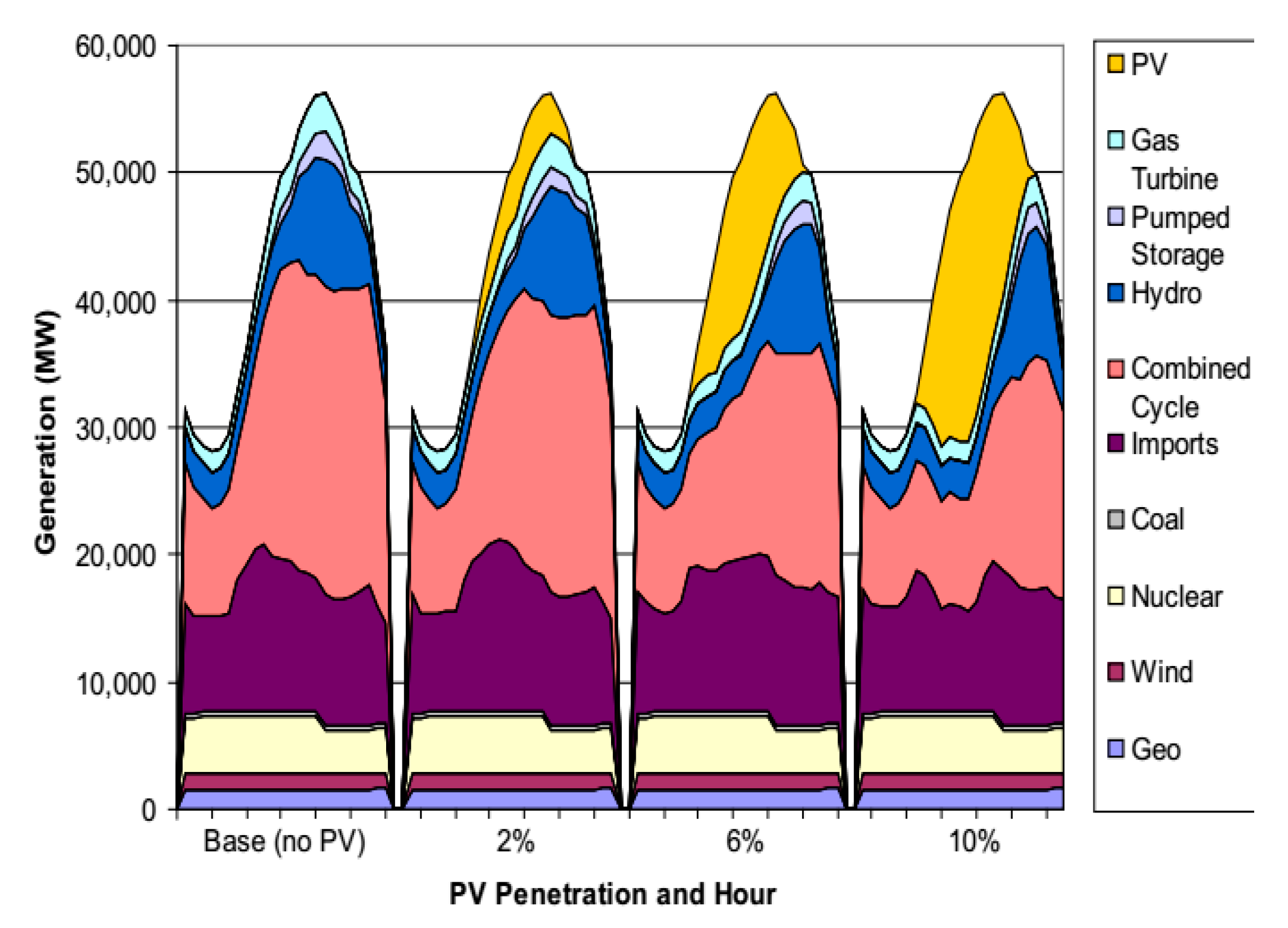

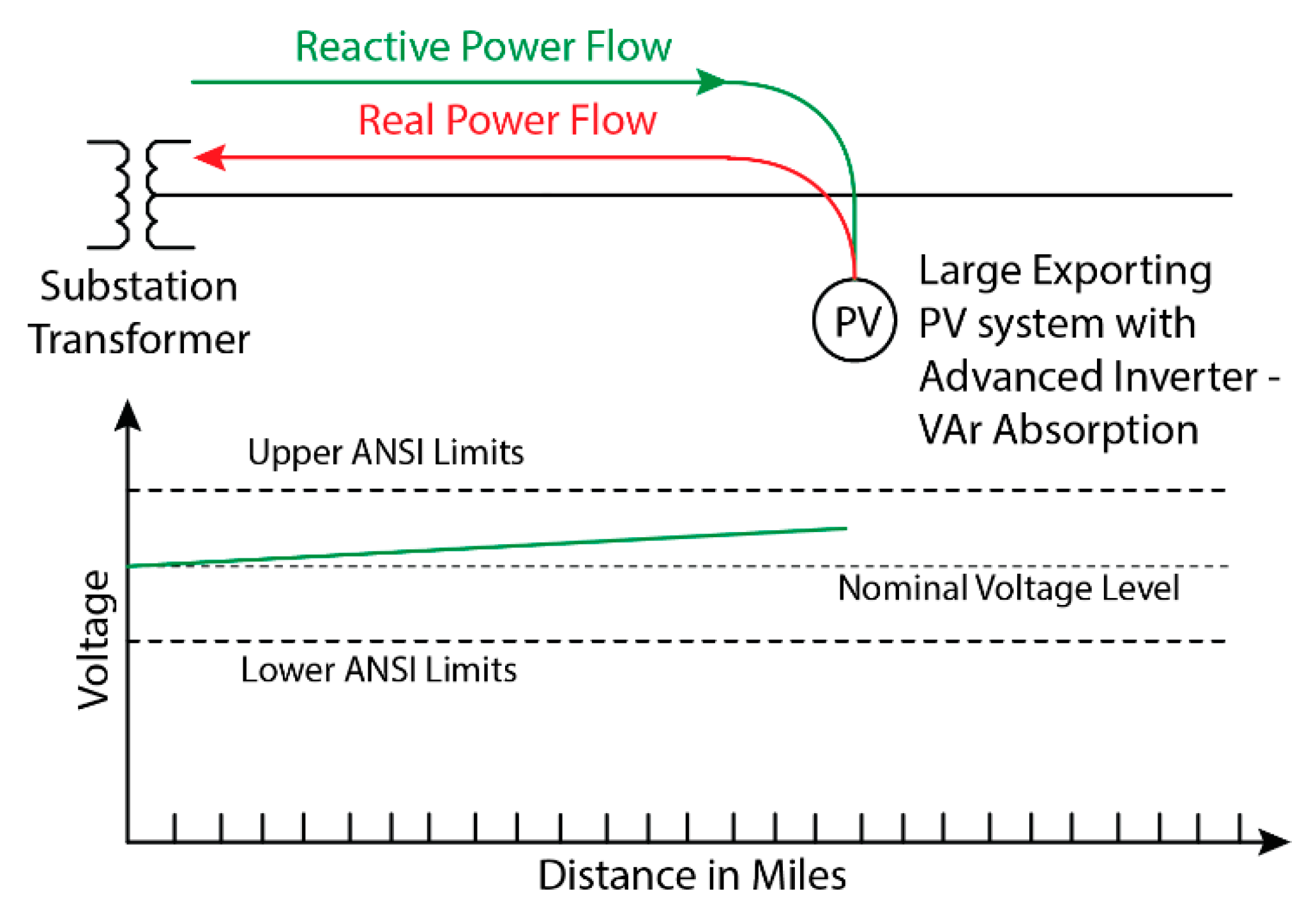
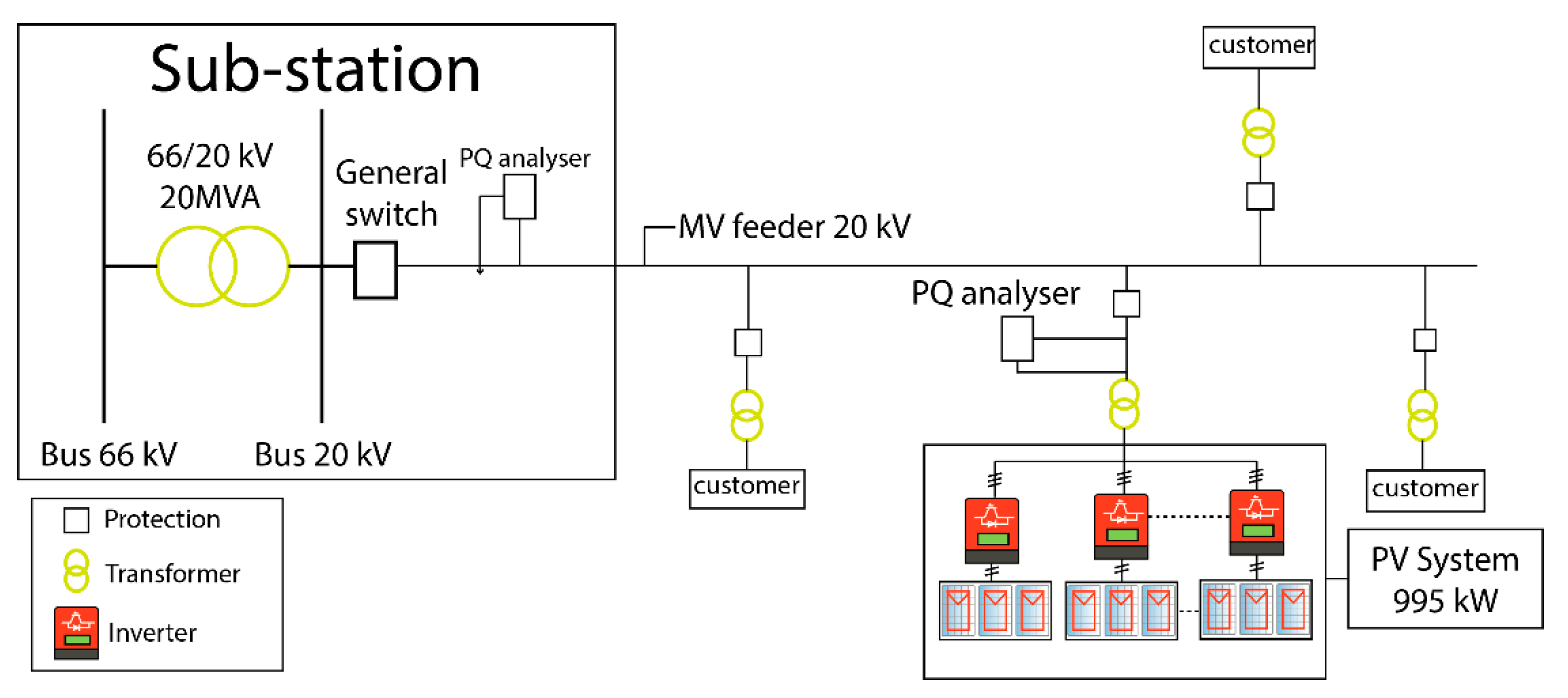
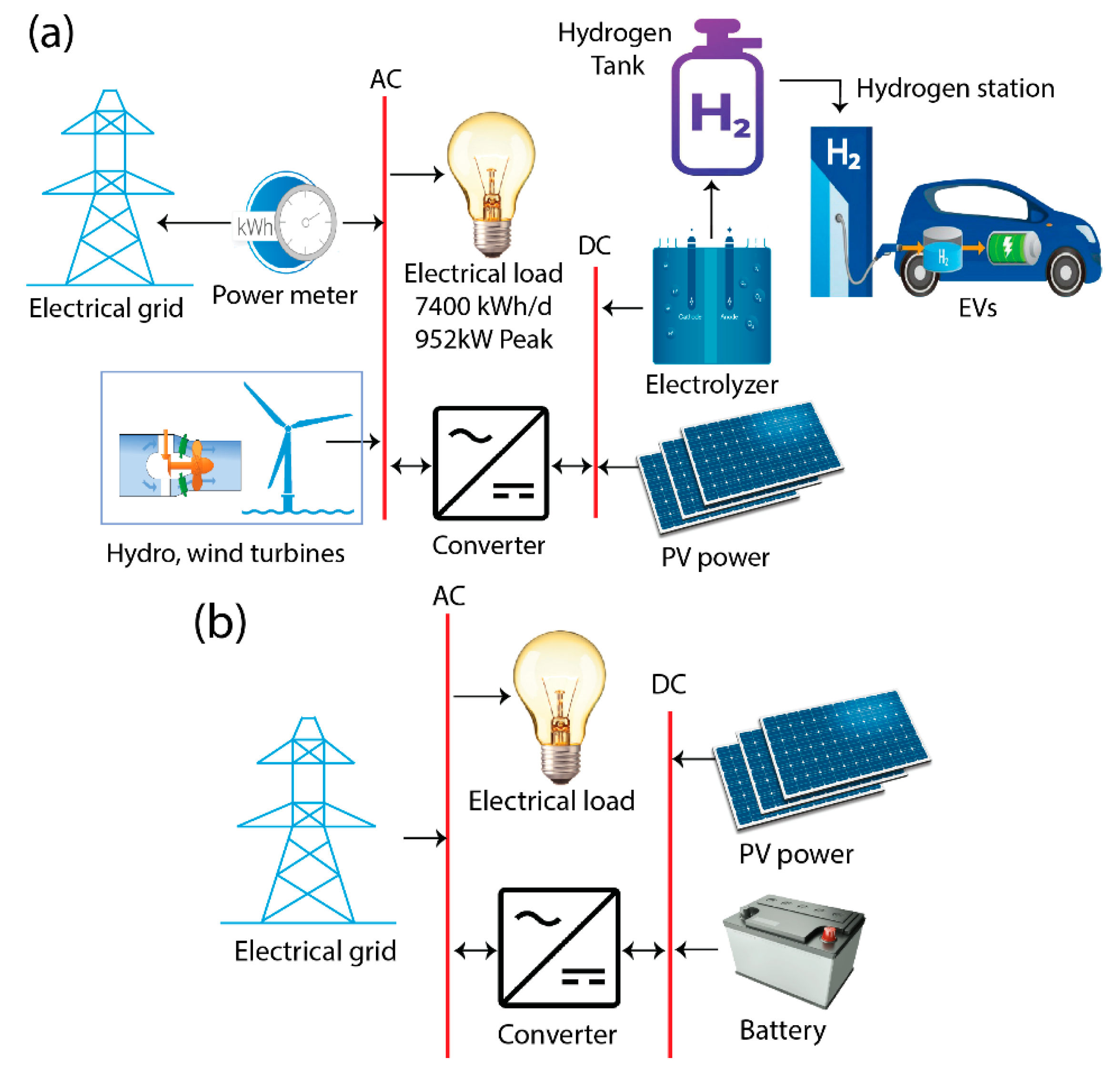

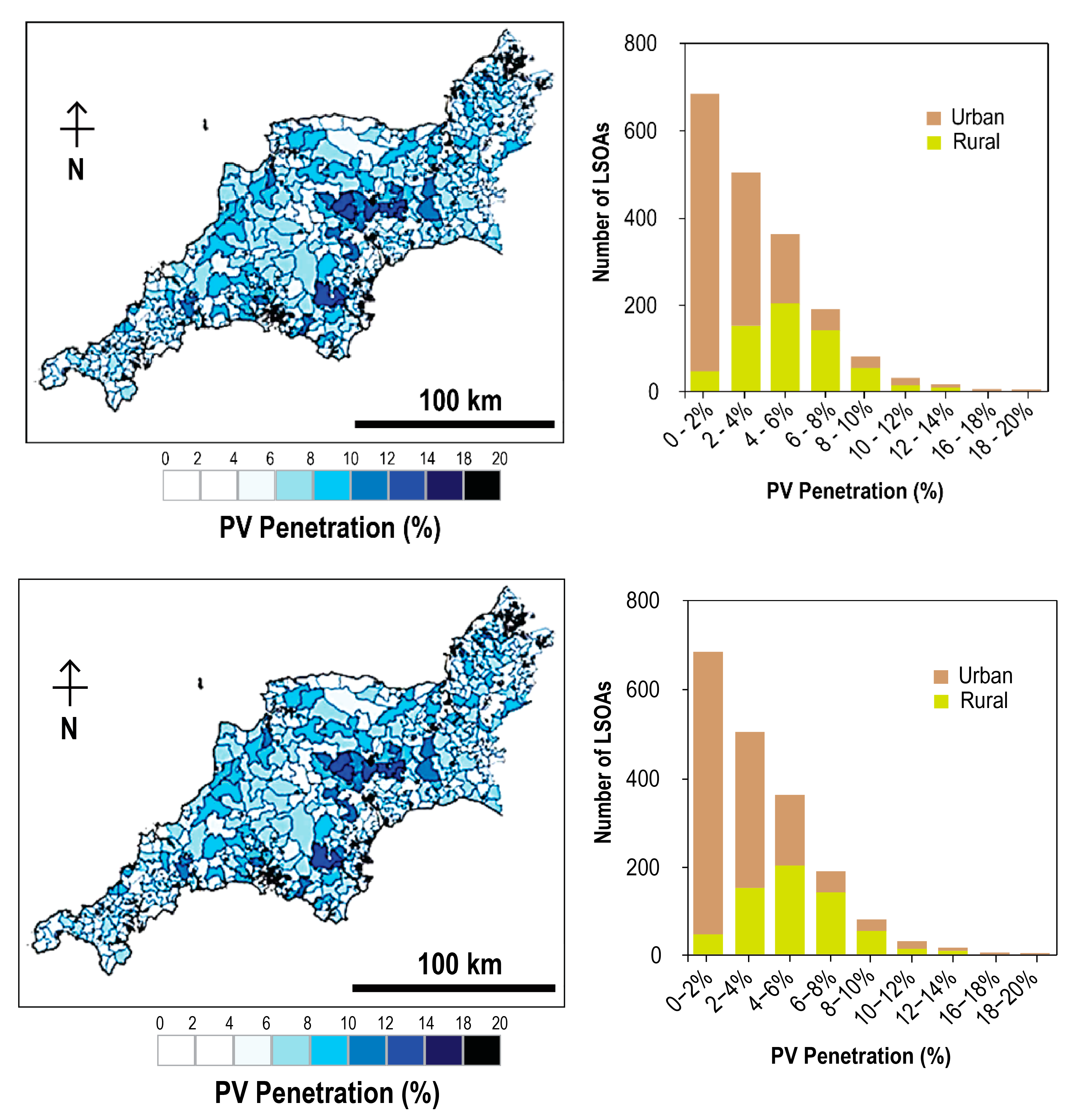
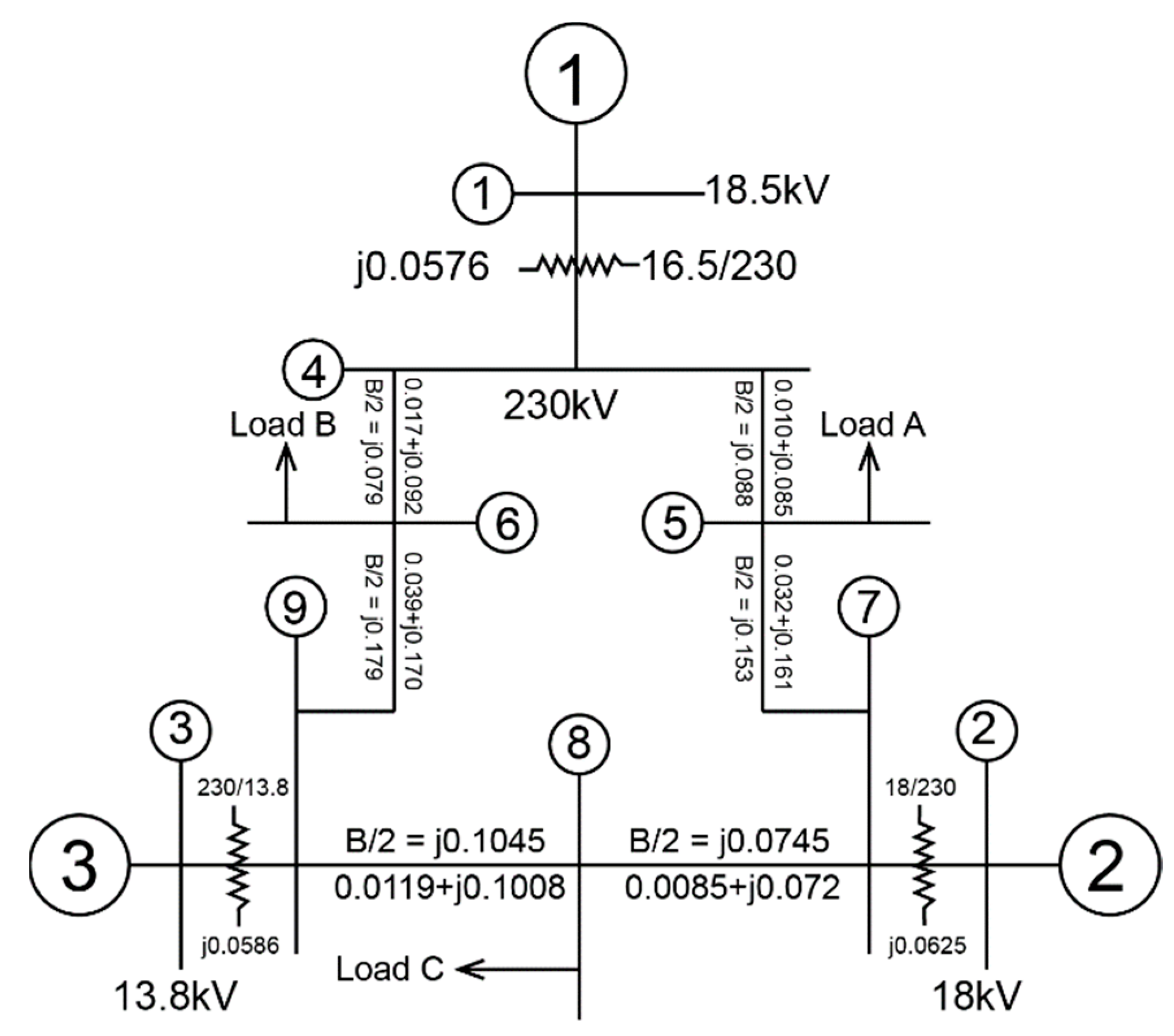
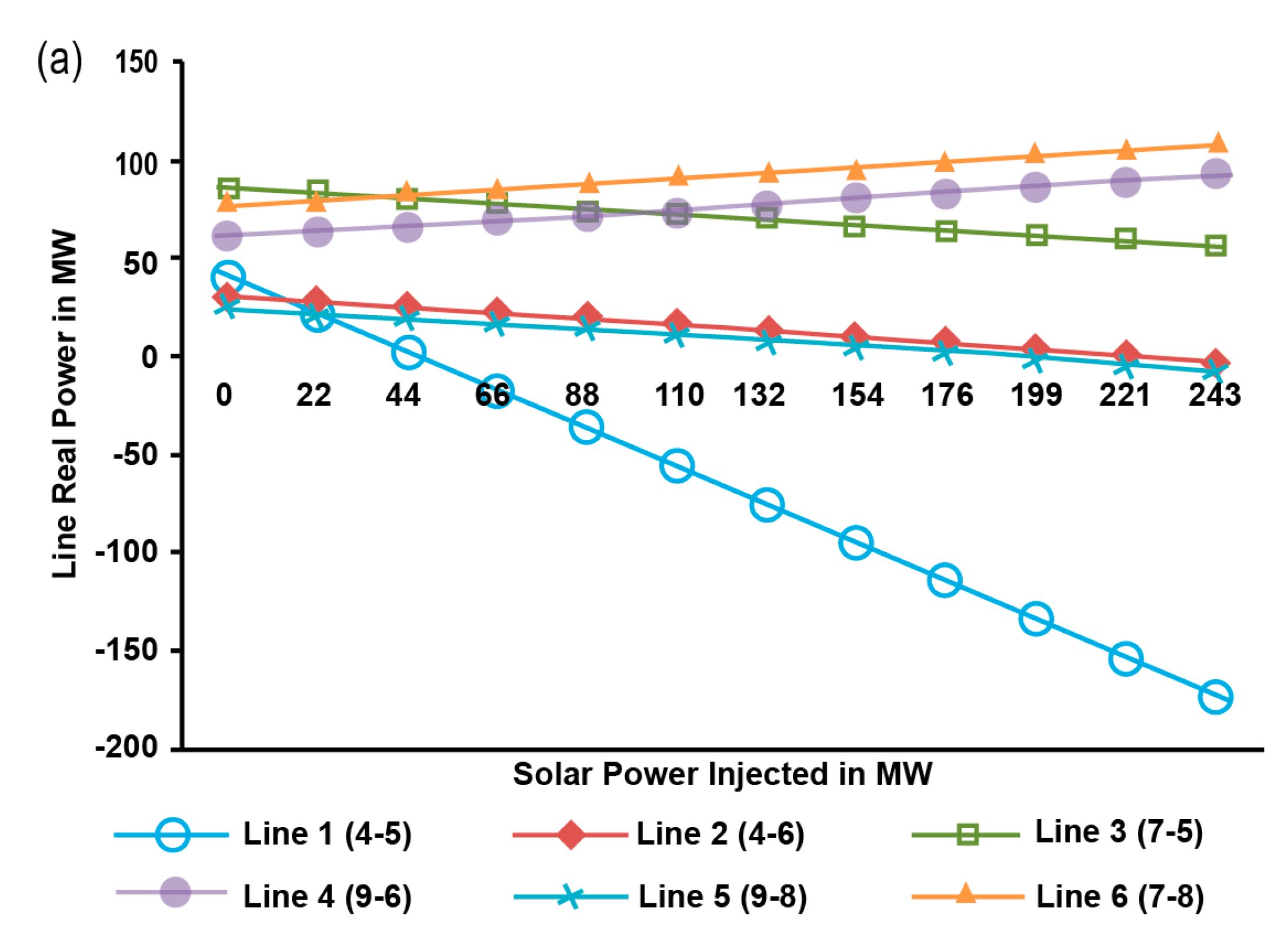
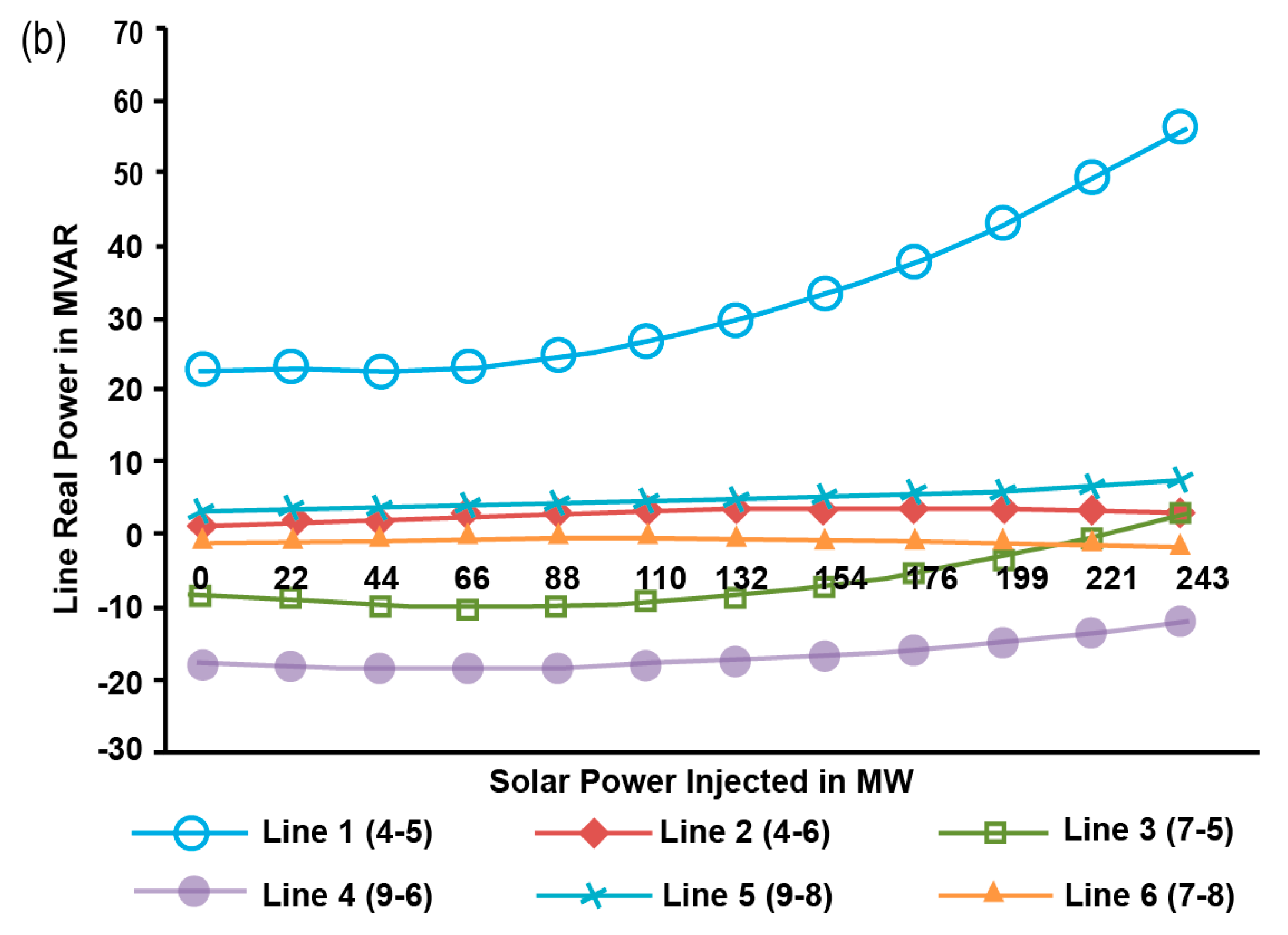
| Circuit Penetration Level | No. of Circuits | Percentage of Circuits | ||||
|---|---|---|---|---|---|---|
| Hawaiian Electric | Hawai’i Electric Light | Maui Electric | Hawaiian Electric | Hawai’i Electric Light | Maui Electric | |
| >120% Daytime Minimum Load (“DML”) | 101 | 21 | 8 | 24.3% | 15.4% | 5.8% |
| >100% up to and including 120% DML | 29 | 9 | 17 | 7.0% | 6.6% | 12.4% |
| ≥75% up to and including 100% DML | 59 | 26 | 21 | 14.2% | 19.1% | 15.3% |
| <75% DML | 227 | 80 | 91 | 54.6% | 58.8% | 66.4% |
| Total | 416 | 136 | 137 | 100.0% | 100.0% | 100.0% |
| Components | Size Options | Interpretation |
|---|---|---|
| PV (kW) | 5–10 | Thin films PV: DC power generation |
| Battery (count) | 2 | S45S25P |
| Converter (count) | 6 | DCMC converter |
| Gird electricity | – | CO2 emission factor 924 g/kWh |
| Challenges | Existing (with Present Penetration Levels) | Future (with Smart Cities, PHEVs, Solar Eclipse, Transactive Energy, Big Data, and Cybersecurity) | Suggested Future Solutions |
|---|---|---|---|
| Reverse Flow of Power | A potential issue, depending on the feeder’s point of interconnection (POI). | An increase is anticipated. Reduced the number of possible points of connection. | Feeders are loaded to a minimum. |
| Concerns about voltage instability | The use of on/off load tap changers has proven to be effective. | Increase anticipated. | Geographic Smoothing (GS) in conjunction with photovoltaic fleet management. |
| Complicated coordination of protection | There are no significant coordination issues with relays/inverters, sectionalizes, fuses, or reclosers. | Increased bidirectional current flow and fault current levels, increased line-to-ground voltage due to an increase in single-phase consumers, possible desensitization of substation relays, fuses blowing unexpectedly, reclosers, and sectionalizes malfunctioning. | Advanced short circuit analysis with a high penetration of photovoltaics. Intelligent Inverter (SI) with fault current monitoring and control. |
| Problems with the power factor | There is no significant concern. | Expected increase. | For both utilities and people who make their electricity, dynamic reactive power control with SI can help them use less power. |
| Harmonics | There is no significant concern. | Expected increase. | All SI conform to UL 1741. SI+ features Dynamic Load Harmonic Control (DLHC). Utilization of Static Synchronous Compensation Devices (STATCOMs). |
| Instability of Frequency | There is no significant concern. Germany’s ‘50.2 Hz’ frequency issue. | Expected increase. | For utility−scale photovoltaic systems, GS with PV aggregation. SI+ Fault Ride Through (FRT), Energy Routing Optimization (OER). |
| Losses at the feeder | Increased slightly depending on the POI. | Future possible increases. | Algorithms for optimal photovoltaic placement that are robust, OER on distribution feeders. |
| The grid’s thermal limits | No discernible effects. | Expected increase. | All SI must comply with UL 1741. Location optimization of utility-scale and small−scale aggregated photovoltaic systems, OER. |
| Supply−chain security | There is no significant issue. | Threatened. | Accurate forecasting methods (for supply security) should include future market analysis. Taking into account the PV system’s intermittent nature as well as the development of other dispatchable energy sources. |
| Cybersecurity in Distributed Energy Resources (DER) and substations | There are no communication or control links. The IEEE 2030 standard has not been completed. | It is necessary to have reliable and well−defined communication and control protocols. In a transactive energy (TE) environment, interoperability of distributed energy resources (DRE) is critical. | Electronic Device That Is Intelligent (IEDs). IEEE 2030 standards in their entirety and adoption by all photovoltaic systems. Architecture for high−performance computing and communication. |
| Dynamic modelling of high penetration photovoltaics | Distribution Management Systems (DMS) based on Geographic Information Systems (GIS) model photovoltaic (PV) systems as a negative load. | System modelling with PHEVs and the rise of prosumers would be needed to figure out how the system works. Modelling energy routes for Internet of Things (IoT) −enabled TE will need to be done. More in-depth studies on the effects of solar eclipses would be needed. | Dynamic PV systems models be developed for remote monitoring and control via GIS-based DMS and GIS−based Energy Management Systems (EMS). |
| Forecasting | Forecasting is inherently uncertain. The level of precision is still quite low. | Accuracy is critical for proper planning, unit commitment, and dispatch. | Forecasting in a hybrid fashion (nowcasting + forecasting). More precise forecasting models through the use of multiple forecasting methods. |
| A problem with dispatching and scheduling | There have been no significant issues reported. | Increased PV penetration in a transactive environment will necessitate the use of optimal power flow and dispatch with a high PV penetration. | Optimal Smart Inverter Scheduling (OSID). The storage system’s optimal set point. Techniques for mitigating forecast and communication errors in (OSID). |
| Challenges for Higher Levels of PV Penetration | Recommendations |
|---|---|
The PV output’s intermittent nature.
|
|
Disclaimer/Publisher’s Note: The statements, opinions and data contained in all publications are solely those of the individual author(s) and contributor(s) and not of MDPI and/or the editor(s). MDPI and/or the editor(s) disclaim responsibility for any injury to people or property resulting from any ideas, methods, instructions or products referred to in the content. |
© 2023 by the authors. Licensee MDPI, Basel, Switzerland. This article is an open access article distributed under the terms and conditions of the Creative Commons Attribution (CC BY) license (https://creativecommons.org/licenses/by/4.0/).
Share and Cite
Hossain, M.S.; Abboodi Madlool, N.; Al-Fatlawi, A.W.; El Haj Assad, M. High Penetration of Solar Photovoltaic Structure on the Grid System Disruption: An Overview of Technology Advancement. Sustainability 2023, 15, 1174. https://doi.org/10.3390/su15021174
Hossain MS, Abboodi Madlool N, Al-Fatlawi AW, El Haj Assad M. High Penetration of Solar Photovoltaic Structure on the Grid System Disruption: An Overview of Technology Advancement. Sustainability. 2023; 15(2):1174. https://doi.org/10.3390/su15021174
Chicago/Turabian StyleHossain, Md. Shouquat, Naseer Abboodi Madlool, Ali Wadi Al-Fatlawi, and Mamdouh El Haj Assad. 2023. "High Penetration of Solar Photovoltaic Structure on the Grid System Disruption: An Overview of Technology Advancement" Sustainability 15, no. 2: 1174. https://doi.org/10.3390/su15021174
APA StyleHossain, M. S., Abboodi Madlool, N., Al-Fatlawi, A. W., & El Haj Assad, M. (2023). High Penetration of Solar Photovoltaic Structure on the Grid System Disruption: An Overview of Technology Advancement. Sustainability, 15(2), 1174. https://doi.org/10.3390/su15021174










